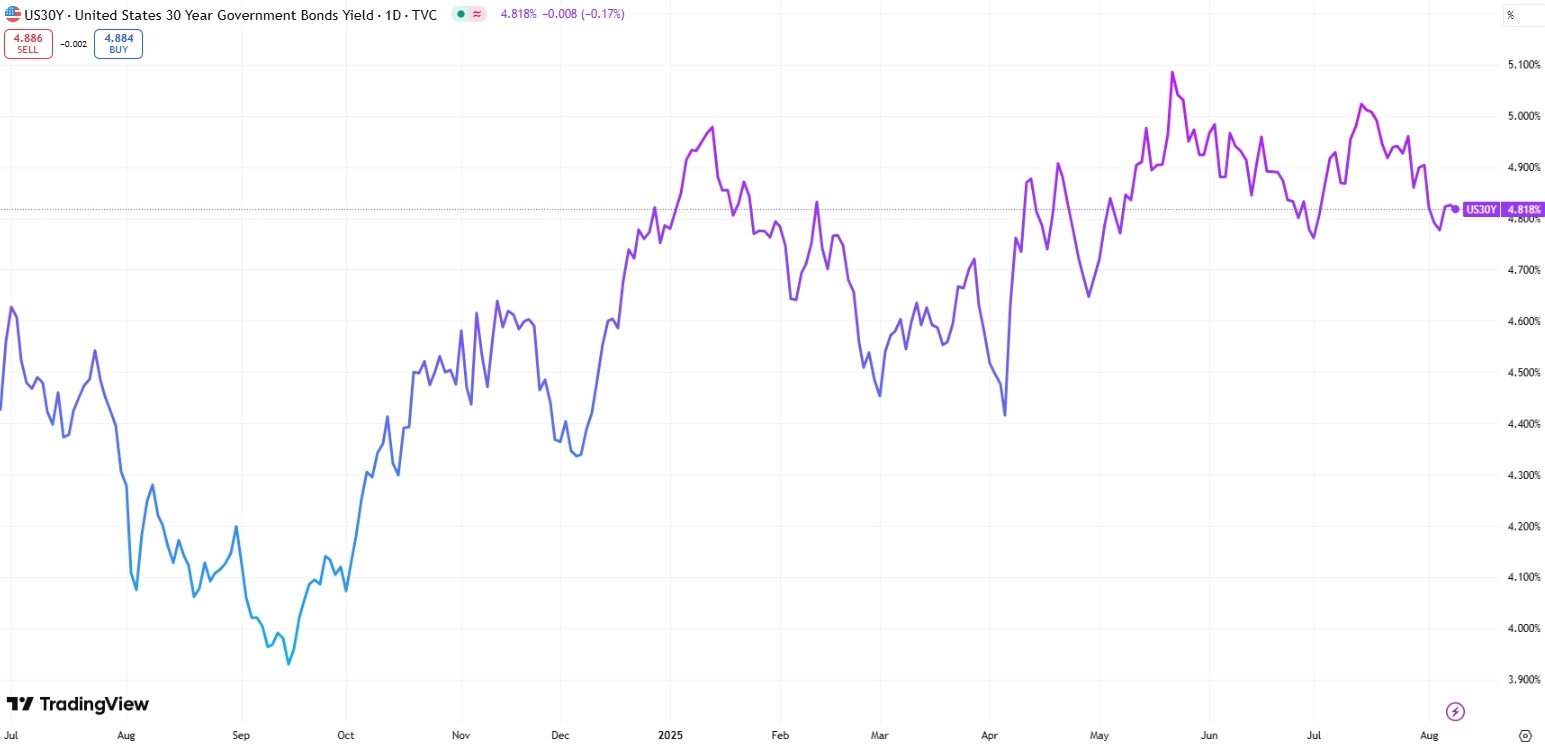U.S. Treasury Auctions Face “Triple Weakness” in August — 30-Year Demand Echoes May’s Bond Market Nightmare

TradingKey - After lackluster auctions of 3-year and 10-year Treasuries earlier in the week, the 30-year bond auction on Thursday, August 7 also showed signs of weak demand — marking a troubling “three-peat” of soft results and reviving memories of May’s long-end bond market turmoil.
The U.S. Treasury auctioned $25 billion in 30-year bonds, with multiple indicators pointing to fading investor appetite:
- High yield (stop-out rate): 4.813%, up from the pre-auction yield of 4.792%, indicating weaker-than-expected demand
- Tail spread: +2.1 bps, the widest since August 2024, signaling pricing pressure
- Bid-to-cover ratio: 2.266%, down from 2.383% in July and the lowest since November 2023 — below the recent six-auction average
- Indirect bidders (foreign central banks and institutions): 59.5%, down from 59.8% and the lowest since May 2025 — second-lowest since 2021
- Direct bidders (U.S. domestic investors like hedge funds, pensions, and banks): 23.03%, a sharp drop from 27.40% in July
- Dealer takedown (the “bidder of last resort”): 17.46%, the highest since August 2024
A Week of Weak Auctions
The 30-year auction capped a disappointing week for Treasury financing:
- $58 billion 3-year note auction (Tuesday):
- Ninth weak auction in the past 11
- Third consecutive auction with a tail
- Indirect bid: 53.99%, the lowest since December 2023
- $42 billion 10-year note auction (Wednesday):
- First tail since February
- Bid-to-cover: 2.32, the lowest in a year
- Indirect bid: 64.2%, the lowest since January
Echoes of May’s Bond Market Stress
The weak results echo the bond market selloff in May, when soft demand for long-dated Treasuries triggered a sharp rise in yields.
At that time:
- The 30-year yield surged to near 5%, levels not seen since the pre-financial crisis era of 2007
- Long-term bond markets in Japan, Germany, and France also weakened
- Investor confidence in U.S. debt as a “safe haven” began to erode

U.S. 30-Year Treasury Yield, Source: TradingView
Why Is Demand Fading?
Analysts cite several structural factors:
- Fading “America First” narrative: The idea that the U.S. is uniquely resilient is losing traction
- Rising fiscal deficits: Concerns over unsustainable debt growth and spending plans like the “Big Beautiful Bill”
- Credit rating downgrade: Moody’s downgraded U.S. sovereign debt earlier in 2025, leaving the U.S. without a triple-A rating from all three major agencies
- Shift in investor mindset: Jeffrey Gundlach, CEO of DoubleLine Capital, warned in June that we are undergoing a paradigm shift. The 40-year era of ‘risk-free’ U.S. bonds is over.
Gundlach added that long-term Treasuries are no longer true safe-haven assets — a sentiment now gaining traction.
Fed Rate Cut Hopes
ZeroHedge notes that the last coupon auction of the week was the ugliest and the bond market saw right through it.
“What is more ominous, is that today's auction is a harbinger of what will happen when Powell finally does cut, and the market immediately reprices inflation expectations, sending long end yields exploding higher in a steepening move that will make your nose bleed. ”
However, with the Fed’s September rate cut widely seen as certain, and President Trump’s new nomination of Stephen Miran — a supporter of Trump’s economic agenda — to the Fed board, the Fed’s decision-making stance may shift further toward dovishness, which is a significant positive for bond prices.
JPMorgan updated its rate cut forecast on Thursday, expecting the Fed to cut rates three times starting in September, by 25 basis points each. Goldman Sachs suggested a 50-basis-point cut in September is also possible.







